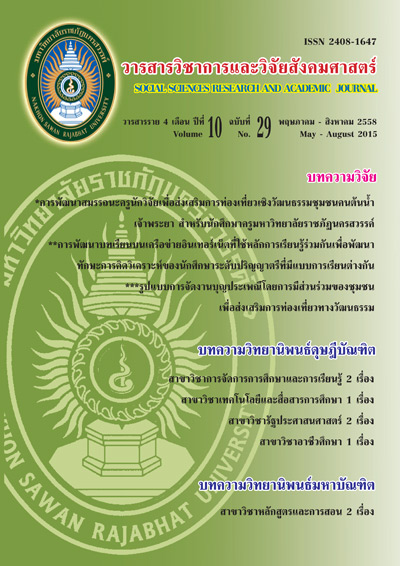การพัฒนาโมเดลเชิงสาเหตุภาวะผู้นำการเปลี่ยนแปลงของผู้บริหารอาชีวศึกษา สังกัดสำนักงานคณะกรรมการการอาชีวศึกษา; The Development of a Causal Model of Transformational Leadership of Vocational Administrators under the Vocational Education Commission Office
Main Article Content
Abstract
บทคัดย่อ
การวิจัยครั้งนี้มีวัตถุประสงค์เพื่อพัฒนาโมเดลเชิงสาเหตุภาวะผู้นำการเปลี่ยนแปลงของผู้บริหารอาชีวศึกษาสังกัดสำนักงานคณะกรรมการการอาชีวศึกษาและตรวจสอบความสอดคล้องกลมกลืนโมเดลเชิงสาเหตุที่พัฒนาขึ้น กลุ่มตัวอย่างได้จากการสุ่มแบบแบ่งชั้น (Stratified Random Sampling) จำนวน 400 คน เก็บรวบรวมข้อมูลโดยใช้แบบสอบถาม สถิติที่ใช้ในการวิเคราะห์ข้อมูลได้แก่ การวิเคราะห์สหสัมพันธ์ (Pearson’s Product Moment Correlation Coefficient) การวิเคราะห์สมการเชิงโครงสร้าง (Structural Equation Models) และการวิเคราะห์เนื้อหา (Content Analysis)
ผลการวิจัย พบว่า โมเดลเชิงสาเหตุภาวะผู้นำการเปลี่ยนแปลงของผู้บริหารอาชีวศึกษา สังกัดสำนักงานคณะกรรมการการอาชีวศึกษามีความสอดคล้องกับข้อมูลเชิงประจักษ์ (2=301.99, df = 131, 2/df=2.305, GFI = 0.983, AGFI = 0.945, RMR = 0.042,RMSEA = 0.044) โมเดล เชิงสาเหตุภาวะผู้นำการเปลี่ยนแปลงของผู้บริหารอาชีวศึกษา ประกอบด้วยปัจจัย การบริหารงานเชิงสถานการณ์ ความฉลาดทางอารมณ์การเสริมสร้างพลังอำนาจในการทำงาน และความยึดมั่นผูกพันต่อองค์การ ซึ่งปัจจัยทั้งหมดสามารถอธิบายความแปรปรวนภาวะผู้นำการเปลี่ยนแปลงของผู้บริหารอาชีวศึกษาได้ร้อยละ 50.3 ปัจจัยที่มีอิทธิพลสูงสุด ได้แก่ การบริหารงานเชิงสถานการณ์ รองลงมาคือ ความฉลาดทางอารมณ์การเสริมสร้างพลังอำนาจในการทำงาน และความยึดมั่นผูกพันต่อองค์การ ตามลำดับ
Abstract
The purposes of this research were to develop and examine causal relationship of model of transformational leadership of vocational administrators under the Vocational Education Commission Office. The stratified random sampling technique was applied to obtain 400 samples as a quantitative data. The statistics used for data analysis were structural equation model analysis and content analysis.
The research results indicated that the model was conformed to empirical data at a good level (c2= 301.997, df = 131, c2/df=2.305, GFI = 0.983, AGFI = 0.945, RMR = 0.042, RMSEA = 0.044). The results from the quantitative data can explain the support statistical finding. The factors of a causal relationship model development of transformational leadership comprise the contingency approach, emotional intelligence, job empowerment, organizational commitment. The causal model revealed 50.3 percent on the variance of transformational leadership. The factors that had effects towards transformational leadership were the contingency approach, emotional intelligence, job empowerment and organizational commitment respectively.


